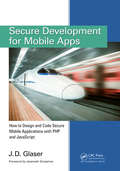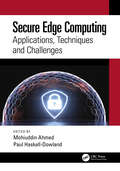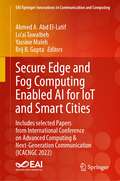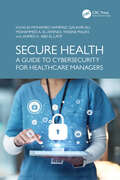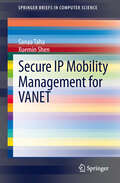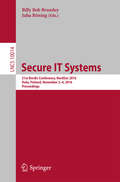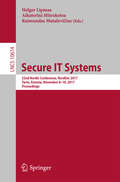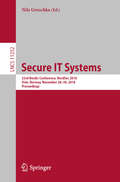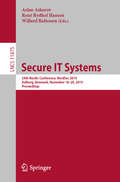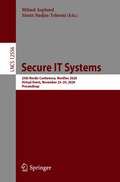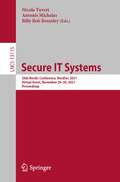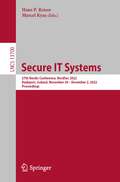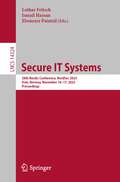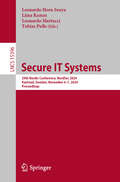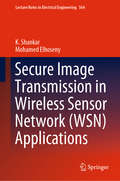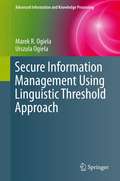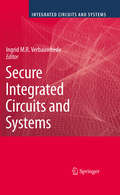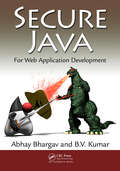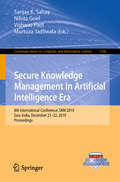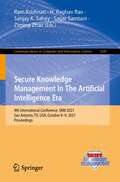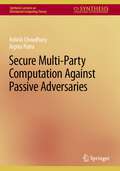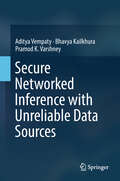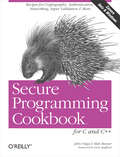- Table View
- List View
Secure Development for Mobile Apps: How to Design and Code Secure Mobile Applications with PHP and JavaScript
by J. D. GlaserThe world is becoming increasingly mobile. Smartphones and tablets have become more powerful and popular, with many of these devices now containing confidential business, financial, and personal information. This has led to a greater focus on mobile software security. Establishing mobile software security should be of primary concern to every mobil
Secure Edge Computing: Applications, Techniques and Challenges
by Mohiuddin Ahmed Paul Haskell-DowlandThe internet is making our daily life as digital as possible and this new era is called the Internet of Everything (IoE). Edge computing is an emerging data analytics concept that addresses the challenges associated with IoE. More specifically, edge computing facilitates data analysis at the edge of the network instead of interacting with cloud-based servers. Therefore, more and more devices need to be added in remote locations without any substantial monitoring strategy. This increased connectivity and the devices used for edge computing will create more room for cyber criminals to exploit the system’s vulnerabilities. Ensuring cyber security at the edge should not be an afterthought or a huge challenge. The devices used for edge computing are not designed with traditional IT hardware protocols. There are diverse-use cases in the context of edge computing and Internet of Things (IoT) in remote locations. However, the cyber security configuration and software updates are often overlooked when they are most needed to fight cyber crime and ensure data privacy. Therefore, the threat landscape in the context of edge computing becomes wider and far more challenging. There is a clear need for collaborative work throughout the entire value chain of the network. In this context, this book addresses the cyber security challenges associated with edge computing, which provides a bigger picture of the concepts, techniques, applications, and open research directions in this area. In addition, the book serves as a single source of reference for acquiring the knowledge on the technology, process and people involved in next generation computing and security. It will be a valuable aid for researchers, higher level students and professionals working in the area.
Secure Edge and Fog Computing Enabled AI for IoT and Smart Cities: Includes selected Papers from International Conference on Advanced Computing & Next-Generation Communication (ICACNGC 2022) (EAI/Springer Innovations in Communication and Computing)
by Brij B. Gupta Yassine Maleh Lo’ai Tawalbeh Ahmed A. Abd El-LatifThis book gathers recent research in security and privacy to discuss, evaluate, and improve the novel approaches of data protection in IoT and edge and fog computing. The primary focus of the book addresses security mechanisms in IoT and edge/ fog computing, advanced secure deployments for large scaled edge/ fog computing, and new efficient data security strategy of IoT and edge/ fog computing. The book lays a foundation of the core concepts and principles of IoT and 5G security, walking the reader through the fundamental ideas. This book is aimed at researchers, graduate students, and engineers in the fields of secure IoT and edge/ fog computing. The book also presents selected papers from International Conference on Advanced Computing & Next-Generation Communication (ICACNGC 2022).
Secure Fusion Estimation and Control for Cyber-Physical Systems Under Malicious Attacks
by Wen-An Zhang Bo Chen Li Yu Tongxiang LiThe book focuses on the issues of secure fusion estimation and control in cyber-physical systems under cyber-attacks, such as privacy protection under eavesdropping attacks, security fusion estimation under DoS and FDI attacks, and model-based and model-free security control under cyber-attacks. The comprehensive and systematic treatment of security protection in cyber-physical systems is one of the main features of the book, which is particularly suitable for readers interested in learning practical solutions for the security of cyber-physical systems. The book can benefit researchers, engineers and graduate students in the fields of control science and engineering, computer science, communication engineering, etc.
Secure Health: A Guide to Cybersecurity for Healthcare Managers
by Yassine Maleh Ahmed A. Abd El-Latif Mohamed Hammad Gauhar Ali Mohammed A. El-AffendiIn today’s interconnected world, healthcare systems are increasingly turning to digital technologies to enhance patient care and optimize operations. However, this digital transformation presents significant challenges in guaranteeing the security and privacy of sensitive healthcare data. Secure Health: A Guide to Cybersecurity for Healthcare Managers confronts these challenges head-on, offering a comprehensive exploration of the latest advancements and best practices in securing digital health systems.From examining the convergence of Internet of Things (IoT) applications with healthcare privacy and security to investigating ethical hacking frameworks and biometric access management, each chapter delves into valuable insights for safeguarding healthcare data in an ever-more digitized landscape. What sets this book apart is its holistic perspective, encompassing not only technical aspects but also governance standards, the unique cybersecurity challenges of telehealth, and the optimization of healthcare supply chain management.KEY FEATURES:• Explores the integration of IoT devices into healthcare and the associated privacy and security risks.• Examines security frameworks and best practices for e-health information governance.• Introduces a novel framework for ethical hacking in digital health.• Analyzes the effectiveness of different artificial intelligence (AI) models for botnet traffic classification.• Delves into the unique challenges of securing telehealth and remote monitoring systems.• Offers practical guidance on securing the future of e-health through smart sensor network management.
Secure IP Mobility Management for VANET
by Xuemin Shen Sanaa TahaThis brief presents the challenges and solutions for VANETs' security and privacy problems occurring in mobility management protocols including Mobile IPv6 (MIPv6), Proxy MIPv6 (PMIPv6), and Network Mobility (NEMO). The authors give an overview of the concept of the vehicular IP-address configurations as the prerequisite step to achieve mobility management for VANETs, and review the current security and privacy schemes applied in the three mobility management protocols. Throughout the brief, the authors propose new schemes and protocols to increase the security of IP addresses within VANETs including an anonymous and location privacy-preserving scheme for the MIPv6 protocol, a mutual authentication scheme that thwarts authentication attacks, and a fake point-cluster based scheme to prevent attackers from localizing users inside NEMO-based VANET hotspots. The brief concludes with future research directions. Professionals and researchers will find the analysis and new privacy schemes outlined in this brief a valuable addition to the literature on VANET management.
Secure IT Systems
by Billy Bob Brumley Juha RöningThis book constitutes the proceedings of the 21st Nordic Conference on Secure IT Systems, held in Oulu, Finland, in November 2016. The 16 full papers presented in this volume were carefully reviewed and selected from 43 submissions.The focus of the conference is on following topics: Security, System Security, Network Security, Software Security, and Information Security.
Secure IT Systems: 22nd Nordic Conference, NordSec 2017, Tartu, Estonia, November 8–10, 2017, Proceedings (Lecture Notes in Computer Science #10674)
by Helger Lipmaa, Aikaterini Mitrokotsa and Raimundas MatulevičiusThis book constitutes the proceedings of the 22nd Nordic Conference on Secure IT Systems, held in Tartu, Estonia, in November 2017.The 18 full papers presented were carefully reviewed and selected from 42 submissions. The papers address a broad range of topics in IT security and privacy. They are organized in the following topical sections: outsourcing computations; privacy preservation; security and privacy in machine learning; applications; access control; and emerging security areas.
Secure IT Systems: 23rd Nordic Conference, NordSec 2018, Oslo, Norway, November 28-30, 2018, Proceedings (Lecture Notes in Computer Science #11252)
by Nils GruschkaThis book constitutes the refereed proceedings on the 23rd Nordic Conference on Secure IT Systems, NordSec 2018, held in Oslo, Norway, in November 2018.The 29 full papers presented in this volume were carefully reviewed and selected from 81 submissions. They are organized in topical sections named: privacy; cryptography; network and cloud security; cyber security and malware; and security for software and software development.
Secure IT Systems: 24th Nordic Conference, NordSec 2019, Aalborg, Denmark, November 18–20, 2019, Proceedings (Lecture Notes in Computer Science #11875)
by René Rydhof Hansen Aslan Askarov Willard RafnssonThis book constitutes the refereed proceedings of the 24th Nordic Conference on Secure IT Systems, NordSec 2019, held in Aalborg, Denmark, in November 2019. The 17 full papers presented in this volume were carefully reviewed and selected from 32 submissions. They are organized in topical sections named: privacy; network security; platform security and malware; and system and software security.
Secure IT Systems: 25th Nordic Conference, NordSec 2020, Virtual Event, November 23–24, 2020, Proceedings (Lecture Notes in Computer Science #12556)
by Simin Nadjm-Tehrani Mikael AsplundThis book constitutes the refereed proceedings of the 25th Nordic Conference on Secure IT Systems, NordSec 2020, which was organized by Linköping University, Sweden, and held online during November 23-24, 2020.The 15 papers presented in this volume were carefully reviewed and selected from 45 submissions. They were organized in topical sections named: malware and attacks; formal analysis; applied cryptography; security mechanisms and training; and applications and privacy.
Secure IT Systems: 26th Nordic Conference, NordSec 2021, Virtual Event, November 29–30, 2021, Proceedings (Lecture Notes in Computer Science #13115)
by Billy Bob Brumley Antonis Michalas Nicola TuveriThis book constitutes the refereed proceedings of the 26th Nordic Conference on Secure IT Systems, NordSec 2021, which was held online during November 2021.The 11 full papers presented in this volume were carefully reviewed and selected from 29 submissions. They were organized in topical sections named: Applied Cryptography, Security in Internet of Things, Machine Learning and Security, Network Security, and Trust.
Secure IT Systems: 27th Nordic Conference, NordSec 2022, Reykjavic, Iceland, November 30–December 2, 2022, Proceedings (Lecture Notes in Computer Science #13700)
by Hans P. Reiser Marcel KyasThis book constitutes the refereed proceedings of the 27th Nordic Conference on Secure IT Systems, NordSec 2022, held in Reykjavic, Iceland, during November 30 – December 2, 2022. The 20 full papers presented in this volume were carefully reviewed and selected from 89 submissions. The NordSec conference series addresses a broad range of topics within IT security and privacy.
Secure IT Systems: 28th Nordic Conference, NordSec 2023, Oslo, Norway, November 16–17, 2023, Proceedings (Lecture Notes in Computer Science #14324)
by Lothar Fritsch Ismail Hassan Ebenezer PaintsilThis book constitutes the proceedings of the 28th Nordic Conference, NordSec 2023, held in Oslo, Norway, during November 16–17, 2023. The 18 full papers included in this volume were carefully reviewed and selected from 55 submissions. This volume focuses on a broad range of topics within IT security and privacy.
Secure IT Systems: 29th Nordic Conference, NordSec 2024 Karlstad, Sweden, November 6–7, 2024 Proceedings (Lecture Notes in Computer Science #15396)
by Leonardo Martucci Leonardo Horn Iwaya Liina Kamm Tobias PullsThis book constitutes the refereed proceedings of the 29th International Conference on Secure IT Systems, NordSec 2024, held in Karlstad, Sweden, during November 6–7, 2024. The 25 full papers presented in this book were carefully reviewed and selected from 59 submissions. They focus on topics such as: Authentication; Cryptography; Cyber-Physical Systems; Cybersecurity and Policy; LLMs for Security; Formal Verification; Mobile and IoT; Network Security; and Privacy.
Secure Image Transmission in Wireless Sensor Network (Lecture Notes in Electrical Engineering #564)
by Mohamed Elhoseny K. ShankarThis book offers an essential guide to Wireless Sensor Networks, IoT Security, Image Processing, Secure Information Systems, and Data Encryption. In addition, it introduces students and aspiring practitioners to the subject of destination marketing in a structured manner. It is chiefly intended for researcher students in the areas of Wireless Sensor Networks and Secure Data Communication (including image encryption, and intrusion detection systems), academics at universities and colleges, IT professionals, policymakers and legislators. Given its content, the book can be used as a reference text for both undergraduate and graduate studies, in courses on Wireless Sensor Networks, Secure Image Processing, and Data Encryption applications. The book is written in plain and easy-to-follow language and explains each main concept the first time it appears, helping readers with no prior background in the field. As such, it is a “must-read” guide to the subject matter.
Secure Information Management Using Linguistic Threshold Approach
by Marek R. Ogiela Urszula OgielaIn recent years, cryptographic techniques for protecting and hiding secret information have been included in directions of research on intelligent information management. Data can be managed securely due to the use of algorithms for ensuring the confidentiality of data, information splitting techniques as well as protocols for sharing information and methods of its reconstruction. This is why techniques of advanced splitting and reconstruction of information form the primary subject of Secure Information Management Using Linguistic Threshold Approach, whose main purpose is to discuss the so-called linguistic threshold schemes for information sharing. An attempt is also made to describe the opportunities of using these techniques to create new models of managing strategic information shared within a commercial organisation or a state institution. Such information is specially protected, and its contents are used only if the authorised users are enabled to access it. This monograph attempts to define a model structure of information flow and for assigning information shares to particular groups of individuals concerned. The proposed information flow model can be integrated into practical solutions within any organisation or institution, improving the functionality of its legacy information systems. The use of strong mathematical cryptographic models to manage information constitutes a scientific innovation and a demonstration of the methods and opportunities of using advanced techniques for confidentially exchanging information in tasks supporting data flow within a commercial organisation. The interdisciplinary nature of the solutions proposed means that the subject of linguistic threshold schemes forming part of intelligent information management becomes a new challenge for the research and application work carried out.The authors of this monograph hope that it will guide readers on an interesting journey through the cutting edge solution in the field of secure information management.
Secure Integrated Circuits and Systems
by Ingrid M.R. VerbauwhedeOn any advanced integrated circuit or "system-on-chip" there is a need for security. In many applications the actual implementation has become the weakest link in security rather than the algorithms or protocols. The purpose of the book is to give the integrated circuits and systems designer an insight into the basics of security and cryptography from the implementation point of view. As a designer of integrated circuits and systems it is important to know both the state-of-the-art attacks as well as the countermeasures. Optimizing for security is different from optimizations for speed, area, or power consumption. It is therefore difficult to attain the delicate balance between the extra cost of security measures and the added benefits.
Secure Java: For Web Application Development
by B. V. Kumar Abhay BhargavMost security books on Java focus on cryptography and access control, but exclude key aspects such as coding practices, logging, and web application risk assessment. Encapsulating security requirements for web development with the Java programming platform, Secure Java: For Web Application Development covers secure programming, risk assessment, and
Secure Knowledge Management In Artificial Intelligence Era: 8th International Conference, SKM 2019, Goa, India, December 21–22, 2019, Proceedings (Communications in Computer and Information Science #1186)
by Vishwas Patil Sanjay K. Sahay Nihita Goel Murtuza JadliwalaThis book constitutes the refereed proceedings of the 8th International Conference On Secure Knowledge Management In Artificial Intelligence Era, SKM 2019, held in Goa, India, in December 2019. The 12 full papers presented were carefully reviewed and selected from 34 submissions. They were organized according to the following topical sections: cyber security; security and artifcial intelligence; access control models; and social networks.
Secure Knowledge Management In The Artificial Intelligence Era: 9th International Conference, SKM 2021, San Antonio, TX, USA, October 8–9, 2021, Proceedings (Communications in Computer and Information Science #1549)
by H. Raghav Rao Sanjay K. Sahay Ram Krishnan Sagar Samtani Ziming ZhaoThis book constitutes the refereed proceedings of the 9th International Conference On Secure Knowledge Management In Artificial Intelligence Era, SKM 2021, held in San Antonio, TX, USA, in 2021. Due to the COVID-19 pandemic the conference was held online. The 11 papers presented were carefully reviewed and selected from 30 submissions. They were organized according to the following topical sections: intrusion and malware detection; secure knowledge management; deep learning for security; web and social network.
Secure Multi-Party Computation Against Passive Adversaries (Synthesis Lectures on Distributed Computing Theory)
by Arpita Patra Ashish ChoudhuryThis book focuses on multi-party computation (MPC) protocols in the passive corruption model (also known as the semi-honest or honest-but-curious model). The authors present seminal possibility and feasibility results in this model and includes formal security proofs. Even though the passive corruption model may seem very weak, achieving security against such a benign form of adversary turns out to be non-trivial and demands sophisticated and highly advanced techniques. MPC is a fundamental concept, both in cryptography as well as distributed computing. On a very high level, an MPC protocol allows a set of mutually-distrusting parties with their private inputs to jointly and securely perform any computation on their inputs. Examples of such computation include, but not limited to, privacy-preserving data mining; secure e-auction; private set-intersection; and privacy-preserving machine learning. MPC protocols emulate the role of an imaginary, centralized trusted third party (TTP) that collects the inputs of the parties, performs the desired computation, and publishes the result. Due to its powerful abstraction, the MPC problem has been widely studied over the last four decades.
Secure Multiparty Computation and Secret Sharing
by Ronald Cramer Ivan Bjerre Damgård Jesper Buus NielsenIn a data-driven society, individuals and companies encounter numerous situations where private information is an important resource. How can parties handle confidential data if they do not trust everyone involved? This text is the first to present a comprehensive treatment of unconditionally secure techniques for multiparty computation (MPC) and secret sharing. In a secure MPC, each party possesses some private data, while secret sharing provides a way for one party to spread information on a secret such that all parties together hold full information, yet no single party has all the information. The authors present basic feasibility results from the last 30 years, generalizations to arbitrary access structures using linear secret sharing, some recent techniques for efficiency improvements, and a general treatment of the theory of secret sharing, focusing on asymptotic results with interesting applications related to MPC.
Secure Networked Inference with Unreliable Data Sources
by Aditya Vempaty Bhavya Kailkhura Pramod K. VarshneyThe book presents theory and algorithms for secure networked inference in the presence of Byzantines. It derives fundamental limits of networked inference in the presence of Byzantine data and designs robust strategies to ensure reliable performance for several practical network architectures. In particular, it addresses inference (or learning) processes such as detection, estimation or classification, and parallel, hierarchical, and fully decentralized (peer-to-peer) system architectures. Furthermore, it discusses a number of new directions and heuristics to tackle the problem of design complexity in these practical network architectures for inference.
Secure Programming Cookbook for C and C++: Recipes for Cryptography, Authentication, Input Validation & More
by Matt Messier John ViegaPassword sniffing, spoofing, buffer overflows, and denial of service: these are only a few of the attacks on today's computer systems and networks. At the root of this epidemic is poorly written, poorly tested, and insecure code that puts everyone at risk. Clearly, today's developers need help figuring out how to write code that attackers won't be able to exploit. But writing such code is surprisingly difficult.Secure Programming Cookbook for C and C++ is an important new resource for developers serious about writing secure code. It contains a wealth of solutions to problems faced by those who care about the security of their applications. It covers a wide range of topics, including safe initialization, access control, input validation, symmetric and public key cryptography, cryptographic hashes and MACs, authentication and key exchange, PKI, random numbers, and anti-tampering. The rich set of code samples provided in the book's more than 200 recipes will help programmers secure the C and C++ programs they write for both Unix® (including Linux®) and Windows® environments. Readers will learn:How to avoid common programming errors, such as buffer overflows, race conditions, and format string problemsHow to properly SSL-enable applicationsHow to create secure channels for client-server communication without SSLHow to integrate Public Key Infrastructure (PKI) into applicationsBest practices for using cryptography properlyTechniques and strategies for properly validating input to programsHow to launch programs securelyHow to use file access mechanisms properlyTechniques for protecting applications from reverse engineeringThe book's web site supplements the book by providing a place to post new recipes, including those written in additional languages like Perl, Java, and Python. Monthly prizes will reward the best recipes submitted by readers.Secure Programming Cookbook for C and C++ is destined to become an essential part of any developer's library, a code companion developers will turn to again and again as they seek to protect their systems from attackers and reduce the risks they face in today's dangerous world.
